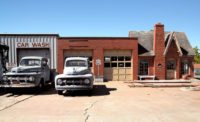For the readers of Architectural Record—particularly of this month’s issue highlighting adaptive reuse—a book such as The Past and Future City probably looks about as fresh as a pile of paper left out for recycling. But it can be perfect for a designer who needs to convince a client of the virtues of recruiting old building stock to new uses, or for a neighborhood group trying to persuade local officials. Stephanie Meeks—CEO of the National Trust for Historic Preservation— has mustered, with Kevin C. Murphy, that organization’s speechwriter, an array of data demonstrating the virtues of architectural adaptation deep enough to convince any remaining doubters. There are even charts to show that you’ll save more money, make more money, create more jobs, revive whole neighborhoods and commercial life, and be more just and ecological if you do the right thing by those old hulks.
She approaches the pro-preservation campaign along many fronts, invoking Jane Jacobs and, to a degree, New Urbanism, unpacking the paradox of why older or modest buildings frequently provide more housing, at more affordable rates, than towers—not to mention healthier, more vibrant neighborhoods. She points out that what attracts tourists—history incarnated in wood, stone, and brick—is also what attracts residents and businesses, offering example after example of downtowns that have bounced back when their old buildings were rehabilitated for new purposes. She specifies means for funding such ventures, like historic tax credits, and describes guidelines that can allow for creative infill without destroying extant streetscape, such as form-based zoning, overlay districts, and, perhaps most innovative, code requirements that permit quirks and certain old-fashioned merits. There is also a chapter on the greenness of reuse—again, nothing that won’t be familiar to architects but that might surprise some developers and civic leaders.
The book is at pains to distinguish the kind of preservation embodied in house museums from that of adaptive reuse; as it turns out, the information about house museums is pretty interesting: I did not know that George Washington’s mansion in Mount Vernon, Virginia, was virtually the first American structure to be made the object of preservation. Before Ann Pamela Cunningham mobilized a group of ladies, starting in 1853, it was in “ruin and desolation.” Now, however, there are “more house museums in the United States than there are McDonald’s restaurants”— many unable to sustain themselves financially. Reuse by organizations and even, with protections, as private homes can be more reliable in preserving them.
At times the book reads like a speech to, say, a foundation board, with sentences that make you long for a red pencil—or for Jane Jacobs, with her crisp, powerful style. It builds its case by accruing examples, which means that you’re following neither arguments nor a story. It may not be a book to read from cover to cover, but as a compendium and reference tool, it can be of critical use in a cause for which no arguing should be required.






Post a comment to this article
Report Abusive Comment